Small businesses with 100 or fewer employees make up 99.7% of all U.S. businesses. If that number sounds too big to be true, consider this: More small businesses are opening than closing for the first time in decades.
On the flip side of things, however, half of small businesses in the United States fail before their fifth birthdays.
This means that small businesses are continuously forming, growing, and failing.

In this dynamic environment, the technology a business uses is often a significant factor in success or failure.
Ginger Siegel—North American small business lead at Mastercard—told Forbes earlier this year that using the right tools to manage daily operations plays a key role in small business longevity.
You don't have to take her word for it, though. Our research validates this claim.
5 disruptive technologies your small business should know
In 2018, we surveyed more than 700 small and midsize business (SMB) leaders in the United States (learn more about our methodology here).
For the second year in a row, our annual survey found that for these leaders, identifying the right technologies for their business is one of their top challenges. And nearly 1 in 5 respondents (19% ) cited it as their main challenge.
Almost half of survey respondents (47%) factor tech trends and advancements into their strategic planning. This means that SMB leaders who don't think strategically about technology change face a high risk of falling behind their competitors or investing in the wrong new technologies for their businesses.
It's not all doom and gloom, though. Our survey identified five disruptive technologies that small businesses are beginning to adopt.
3 key findings on the state of small business tech adoption:
One in 3 U.S.-based banking and financial services SMB leaders says that conversational user interfaces (CUIs) are critical for them to do business.
Two in 3 U.S.-based construction SMB leaders don't believe that digital marketing is critical for them to do business.
More than half of U.S.-based manufacturing/natural resource SMB leaders are currently using the internet of things (IoT).
Small business leaders must make informed, strategic choices on when and how to employ these technologies. Even if you decide to wait and see, you should explicitly identify the conditions your business considers adoption triggers and the actions to take if those triggers materialize.
Let's take a look at these five disruptive technologies, associated challenges you may encounter, and our recommended response to help future-proof your SMB.
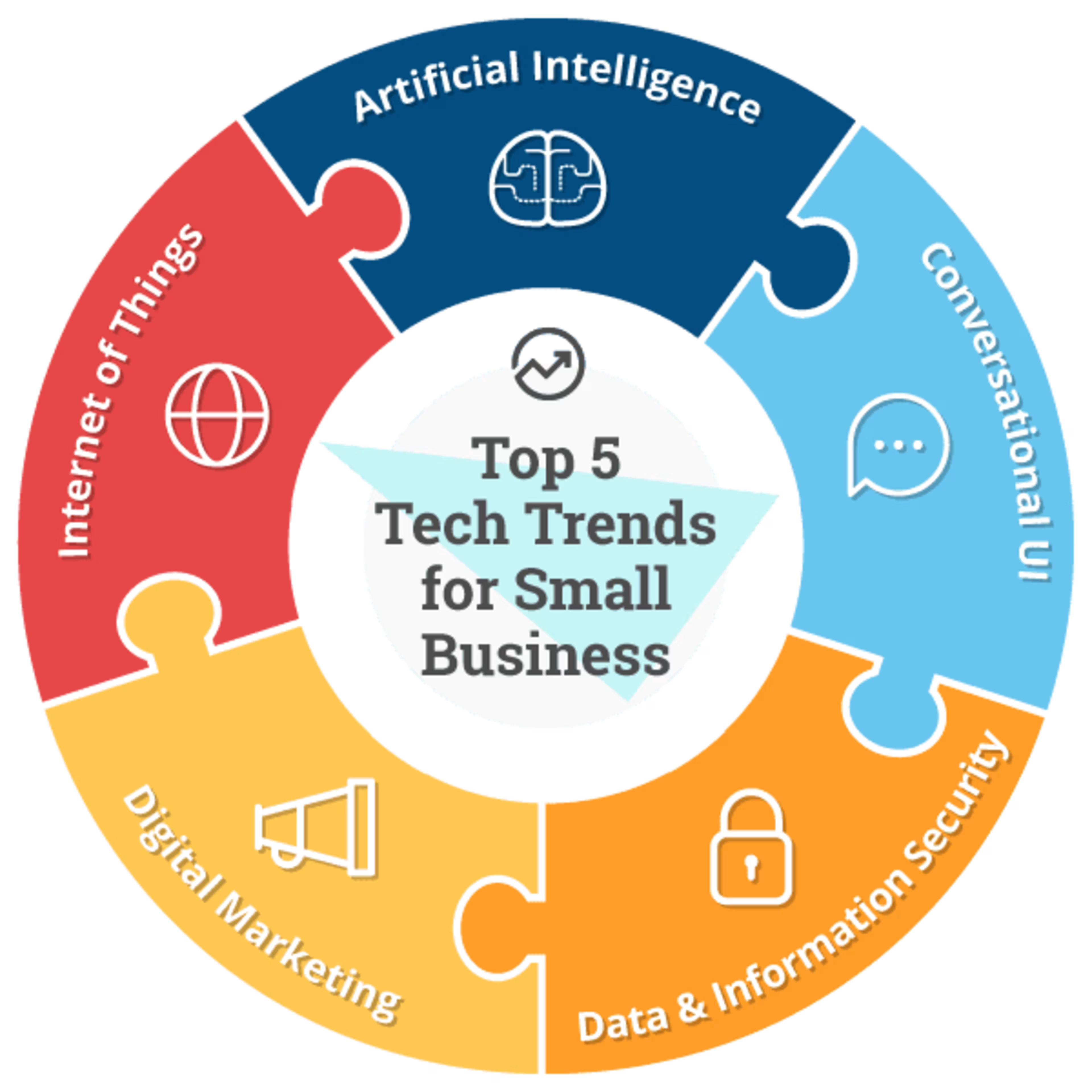
Artificial intelligence
According to Gartner, “Artificial intelligence is technology that appears to emulate human performance typically by learning, coming to its own conclusions, appearing to understand complex content, engaging in natural dialogs with people, enhancing human cognitive performance (also known as cognitive computing) or replacing people on execution of nonroutine tasks."
Artificial intelligence (AI) isn't a singular technology: It's an umbrella term to describe a range of techniques that use technology to mimic human performance.
Though all of the trends discussed within this article roll under AI, each trend is an example of narrow AI: AI that's designed to perform one specific, rules-based, repetitive task.
This is fundamentally different from general AI: AI that purports to have the same range of emotions and cognitive abilities as humans.
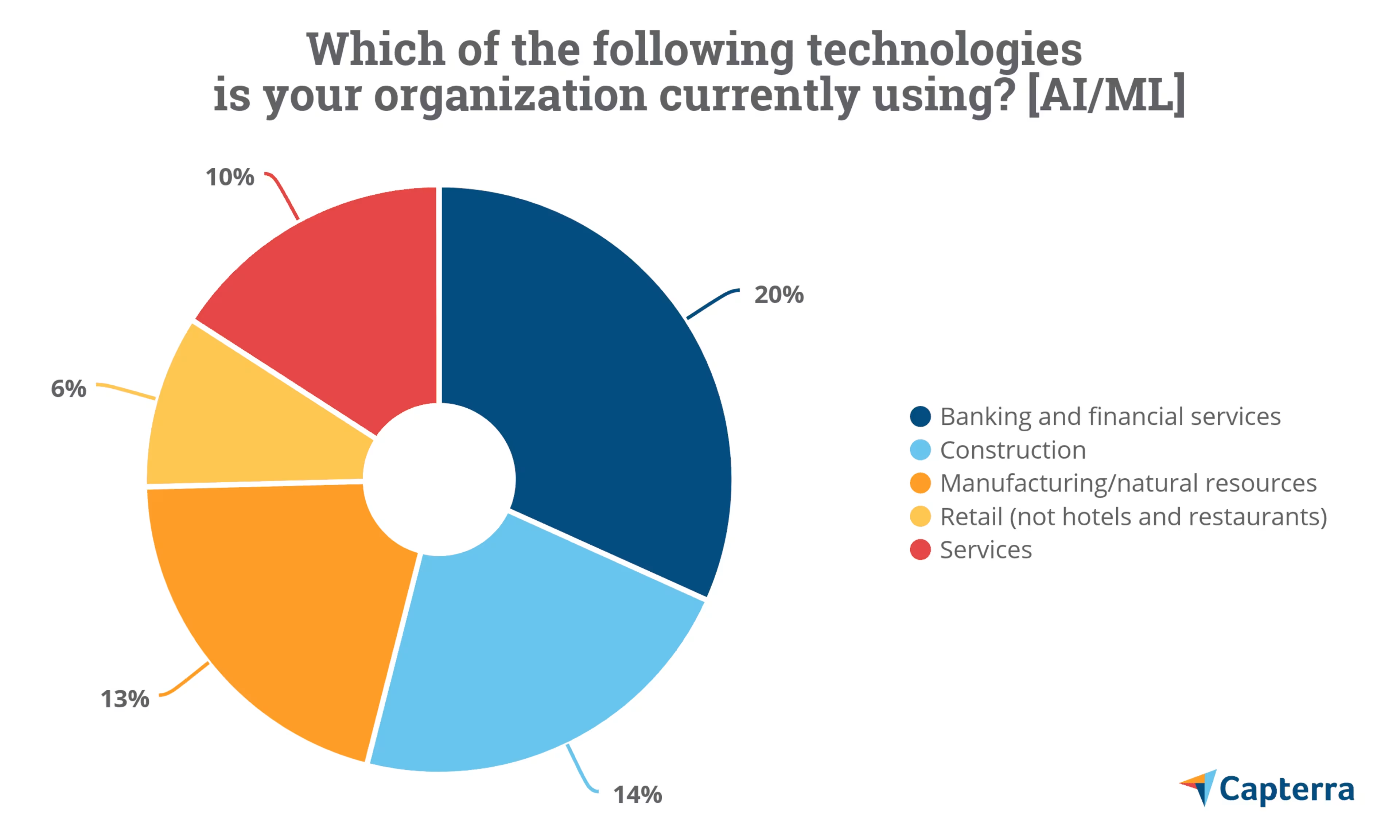
Results of a survey question asking SMB leaders in several industries if they are currently using artificial intelligence/machine learning. All percentages reflect the number of respondents in each industry currently using AI/ML.
Your challenge: AI is the definition of hype. Despite life-changing proclamations, only one in five (or fewer) SMB leaders in the U.S. currently use it.
This is partially because AI is often portrayed as a stand-alone technology that can replace human colleagues, a viewpoint that both over and underestimates AI's current capabilities.
As a result, SMB owners avoid investing in AI that could help their human team members work smarter. Our survey confirmed this, showing that fewer than one in five business leaders use AI, yet many acknowledge that it's critical for their business.
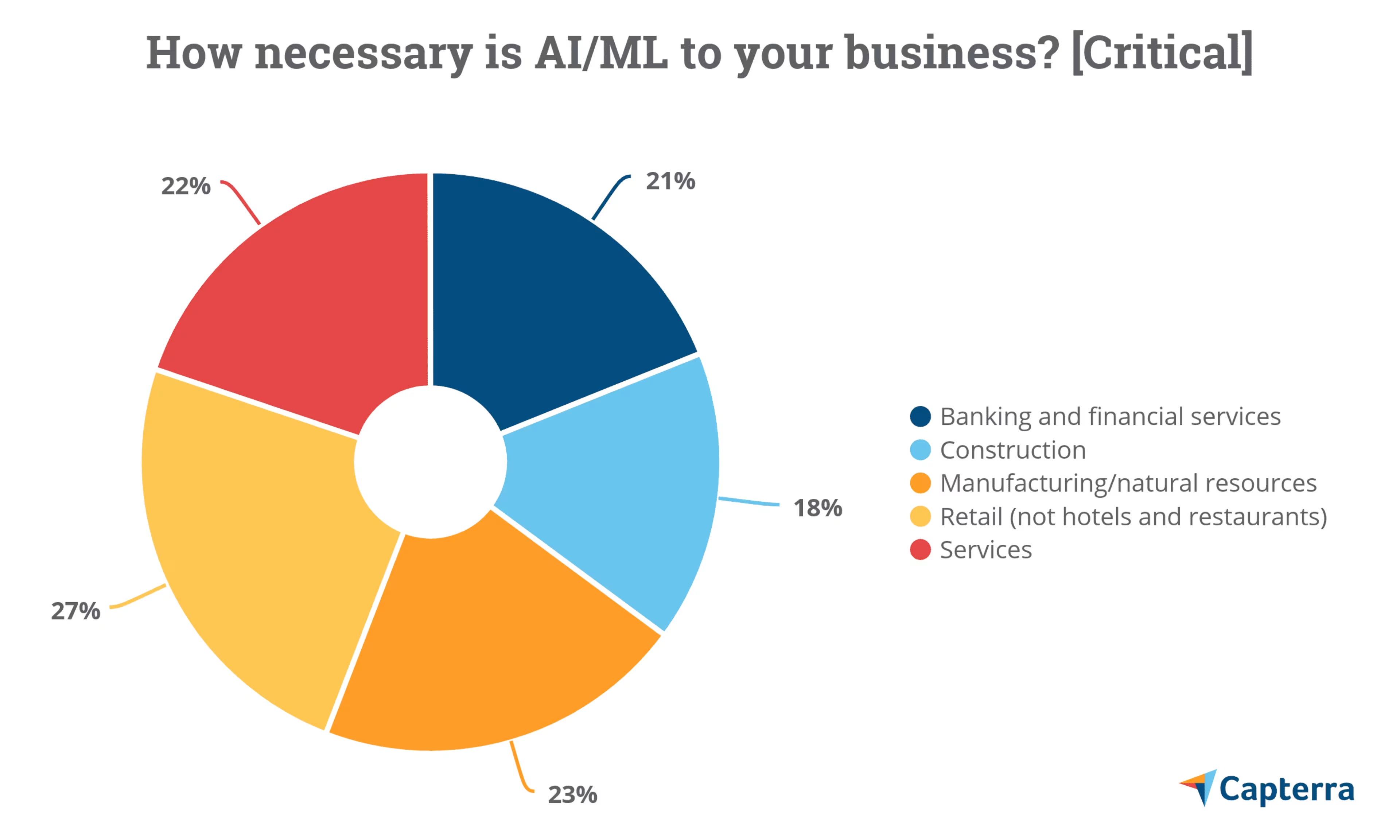
Results of a survey question asking SMB leaders in several industries how necessary artificial intelligence/machine learning is to their businesses. All percentages reflect the number of respondents in each industry who identified AI/ML as critical.
Recommended response: Include AI in your software evaluation process. Many popular vendors, including Slack (communication), Xero (accounting), and Google Drive (file storage and collaboration) already incorporate AI through features such as auto reply.
If you connect specific business outcomes to specific AI technologies, the technology becomes far less daunting.
Conversational user interface
CUIs, which fall under the AI umbrella, are computer programs that mimic conversations with real humans. Commonly known as chatbots, one of their core value propositions is to give users a tailored experience based on unique data.
So, perhaps it's no surprise that SMBs in consumer-based industries are adopting chatbots.
But there's one big problem: SMBs aren't adopting chatbots fast enough to keep pace with consumer demand.
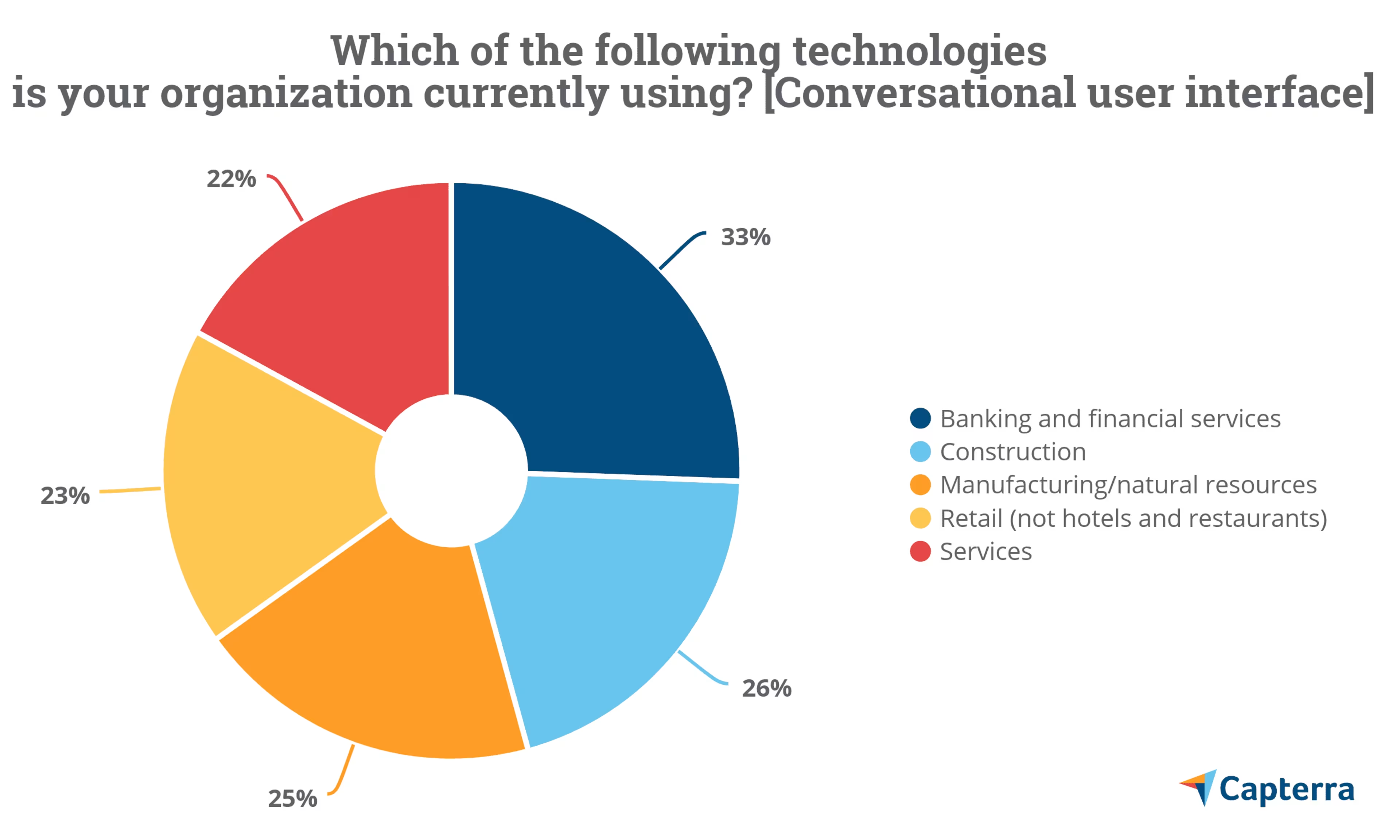
All percentages reflect the number of respondents in each industry currently using CUIs.
Your challenge: Gartner research consistently shows that most U.S. SMBs either don't use chatbots or plan to do so within the next one to two years.
But 65% of U.S. millennials want to use them, and Gartner predicts that by 2019, three times more businesses will use chatbots than used them in 2017. This exhibits a sizable gap between consumer needs and SMB investments.
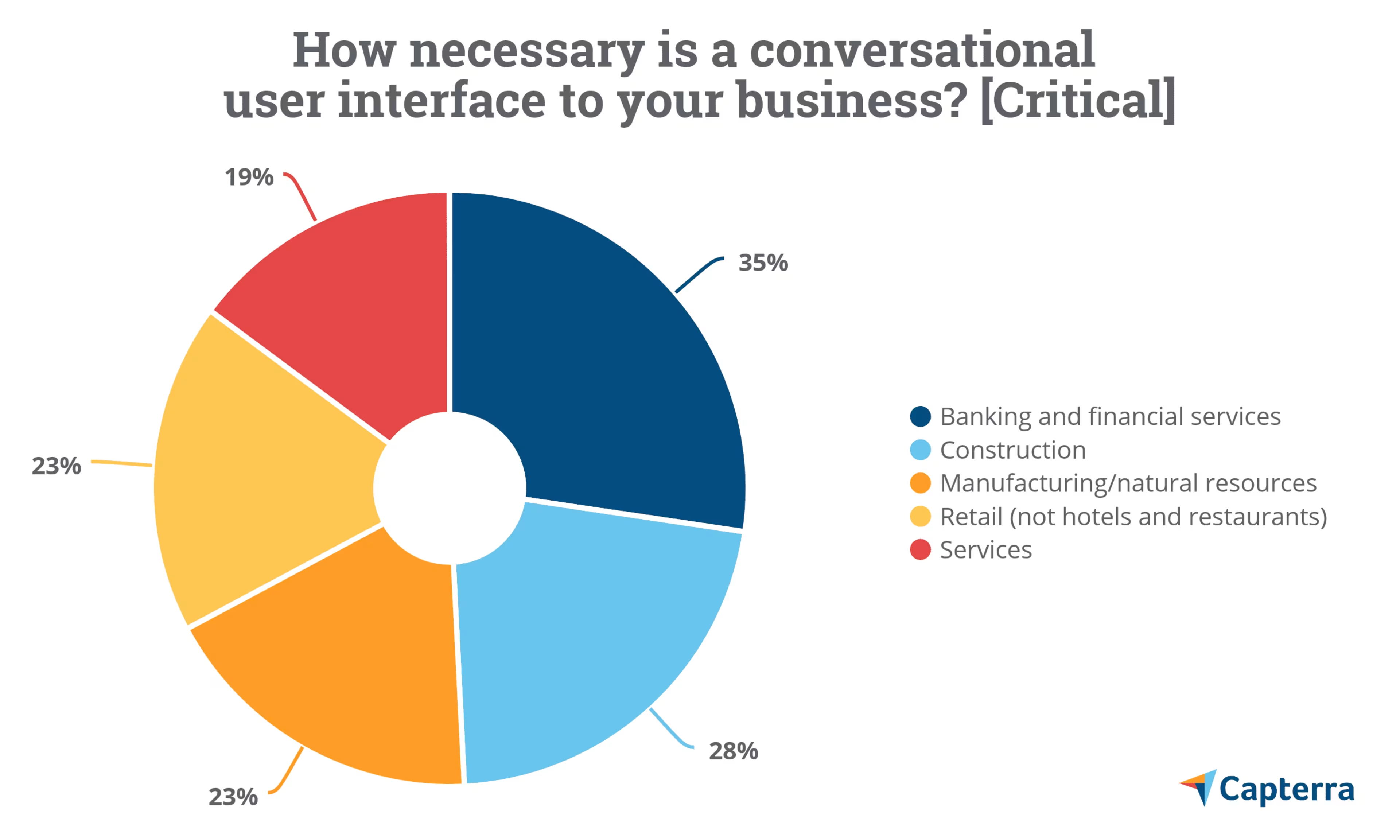
All percentages reflect the number of respondents in each industry who identified CUIs as critical.
Recommended response: Shop for live chat software that integrates with the cloud-based tools your team already uses, and explore the benefits it can offer your business.
CUIs are especially helpful for B2C businesses that communicate with customers (e.g., banking) and work with suppliers (e.g, retail). Geotargeting, screensharing, and auto replies that address common customer problems can help you surpass your peers' customer service.
Data and information security
Data and information security (aka cybersecurity) refers to protecting information across all domains. This isn't a new technology in itself: Data is a company's most precious asset, and SMBs that collect lots of it are at risk.
Here's what is new: More data exists than ever before. This is in large part because of the prevalence of smart devices, ranging from thermostats to tractors. So, although cybersecurity isn't an "emerging" technology, the state of cybersecurity today is arguably more dire than ever.
The rise in data production and doing business online is a hacker's biggest boon. So, it's no surprise that most SMBs across the five industries discussed here say that they're using data and information security tech.
But this comes with a catch: Many of these same SMBs underestimate the security risks that exist within their own companies.
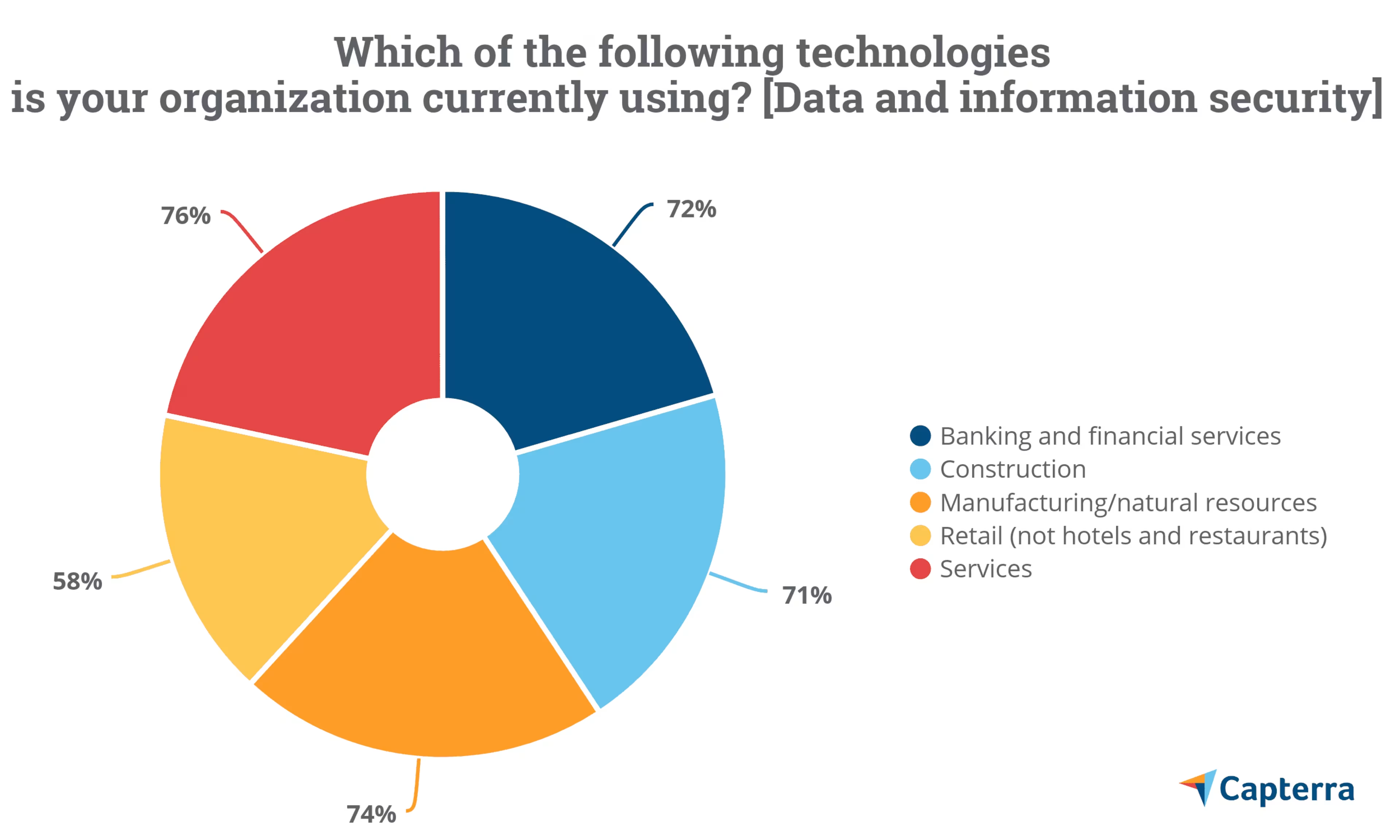
All percentages reflect the number of respondents in each industry currently using data and information security tech.
Your challenge: Most SMBs report using data and information security technology, but half of all U.S. SMBs fell prey to cyberattacks within the past year.
In an ironic twist, disruptive technologies such as AI and the IoT make this problem worse. Most of today's cyberattacks use automation to exploit the biggest security risk that SMBs have: their own employees.
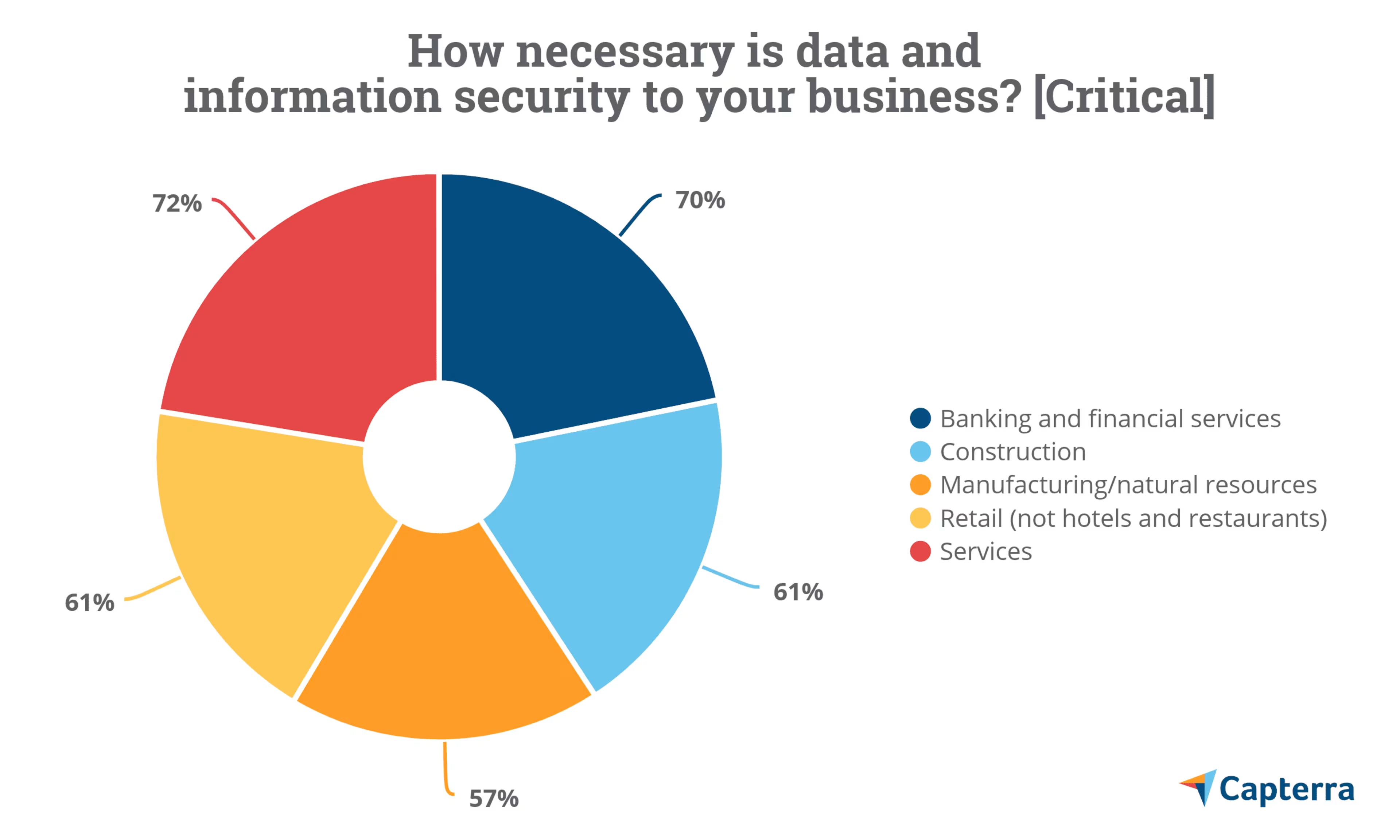
All percentages reflect the number of respondents in each industry who identified data and information security tech as critical.
Recommended response: Assess your SMB's internal security risks. Make this a joint effort between your business and IT leads that addresses all four aspects of a security assessment.
Once you have your assessment results, build a security training plan to share with all current and future team members. Sixty percent of small businesses that suffer data breaches go under within six months. The stakes are too high for you to not train your team.
Digital marketing
If you promote your business online, you practice digital marketing. It's a broad practice that “extends the marketing process through channels such as the web, video, mobile and social applications, point-of-sale terminals, digital signage, and kiosks."
In our interconnected era, it's almost impossible to run a business without an online presence. But there's a gap between use among SMBs and perception of how critical digital marketing is to their businesses.
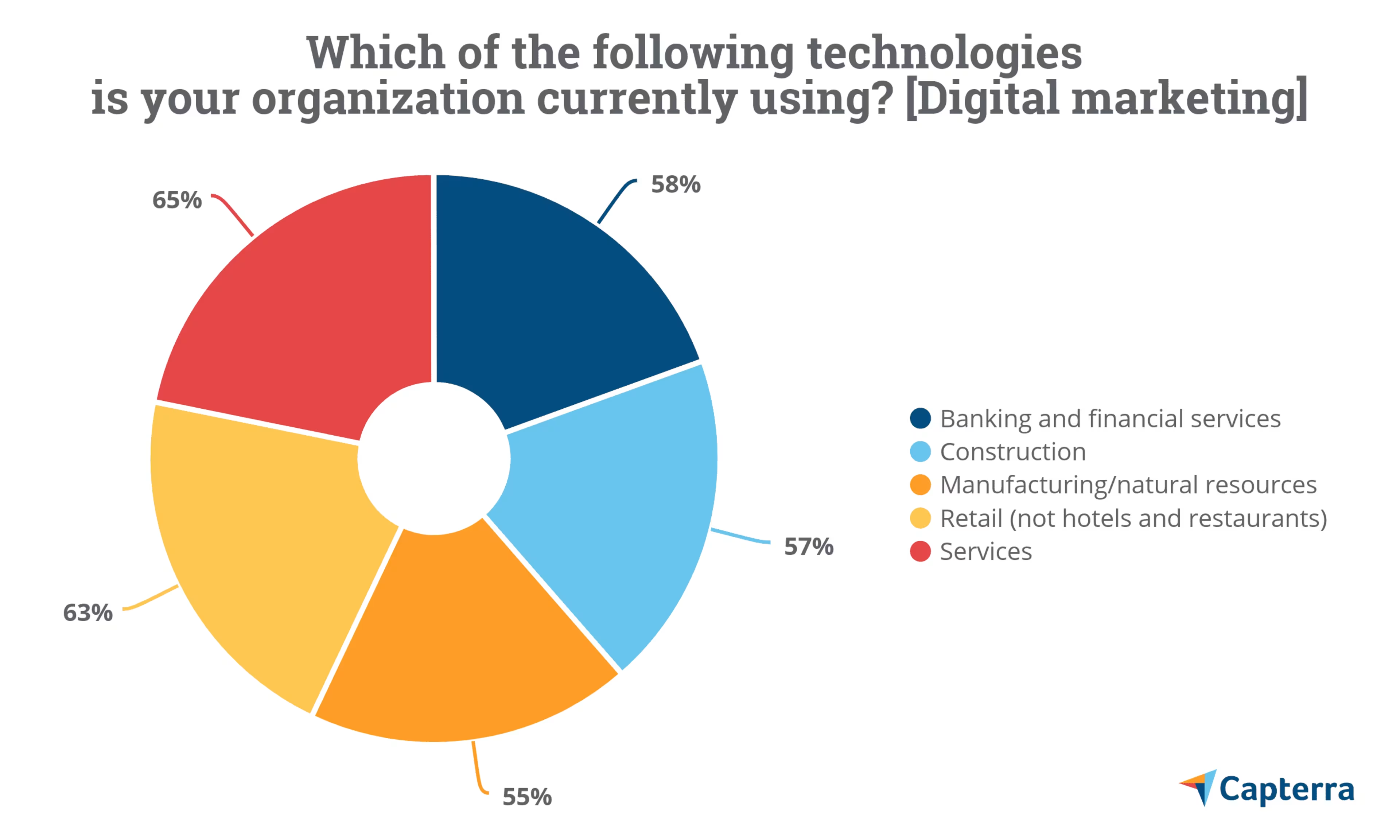
All percentages reflect the number of respondents in each industry currently using digital marketing.
Your challenge: More than half of SMBs within these five industries currently use digital marketing strategies. But it's a term so broad that it can mean everything and nothing.
Let's say you use digital marketing software with dashboards. Even if each metric is at your fingertips, knowledge isn't power on its own. Without knowing which marketing metrics matter most, you won't know which digital marketing tactics to use.
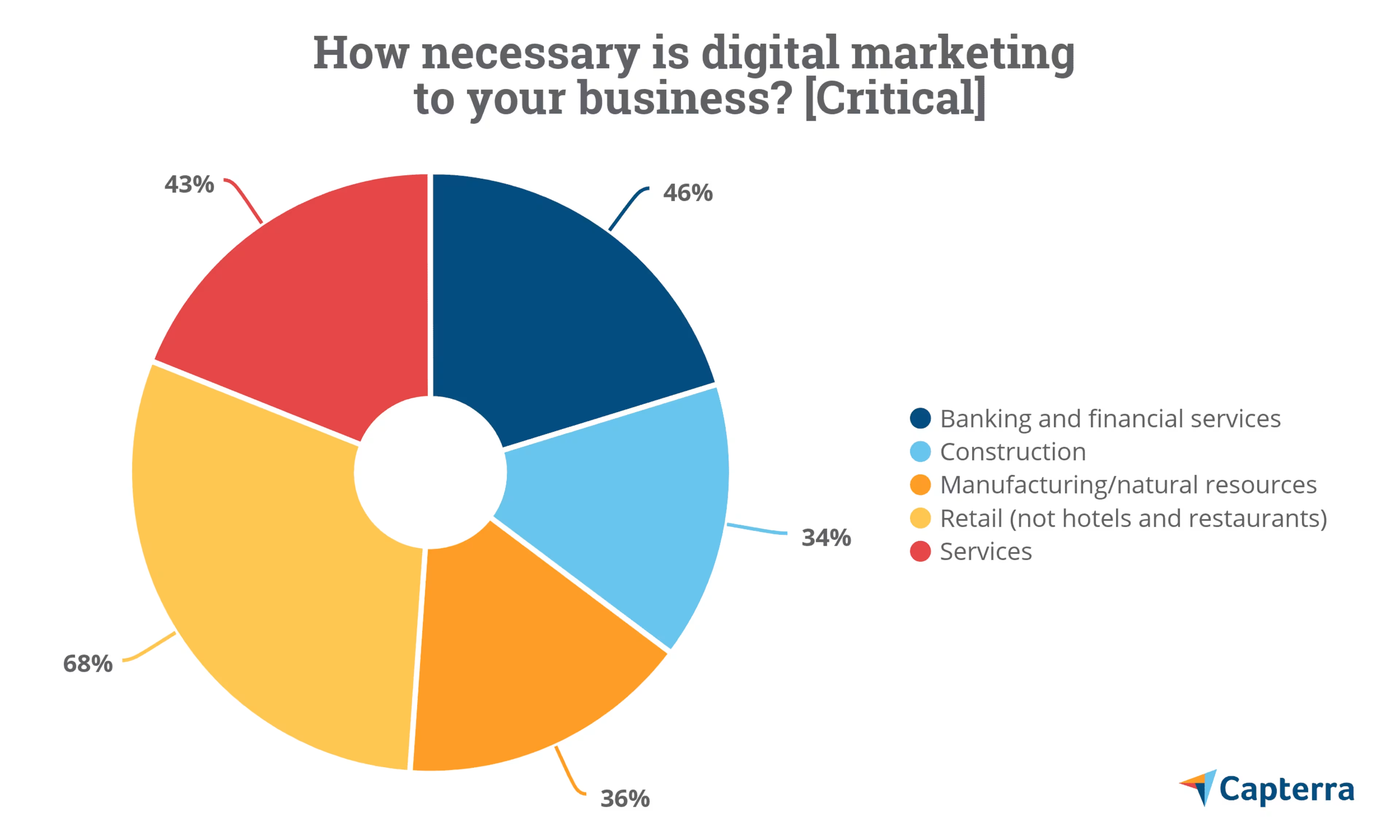
All percentages reflect the number of respondents in each industry who identified digital marketing as critical.
Recommended response: Assess digital marketing software that includes AI-powered features, such as conversational experiences, semantic analysis, content generation, and augmented analytics.
Digital marketing isn't a magic bullet: It will only help your business to a point if you don't know your most important metrics.
If you assess advanced functionality during your software selection process, you can gain a clearer picture of how AI-powered features can help your business reach its goals (such as using software that predicts audience reactions to marketing campaigns within unique markets).
The internet of things
According to Gartner, the IoT "is the network of physical objects that contain embedded technology to communicate and sense or interact with their internal states or the external environment."
It's often referenced in the context of household appliances, such as the Nest thermostat that connects to your home's wireless network. But the IoT is quickly rising to the forefront of SMB tech as well: 47% of leaders we surveyed are currently using the IoT, and 1 in 3 (34%) say the IoT is critical for them to do business.
Here's an example: Some leading edge HVAC service providers are offering new optimization and preventive maintenance services where they attach sensors to an HVAC system, provide customers with a “systems health report," and automatically deliver anticipated and unanticipated maintenance work.
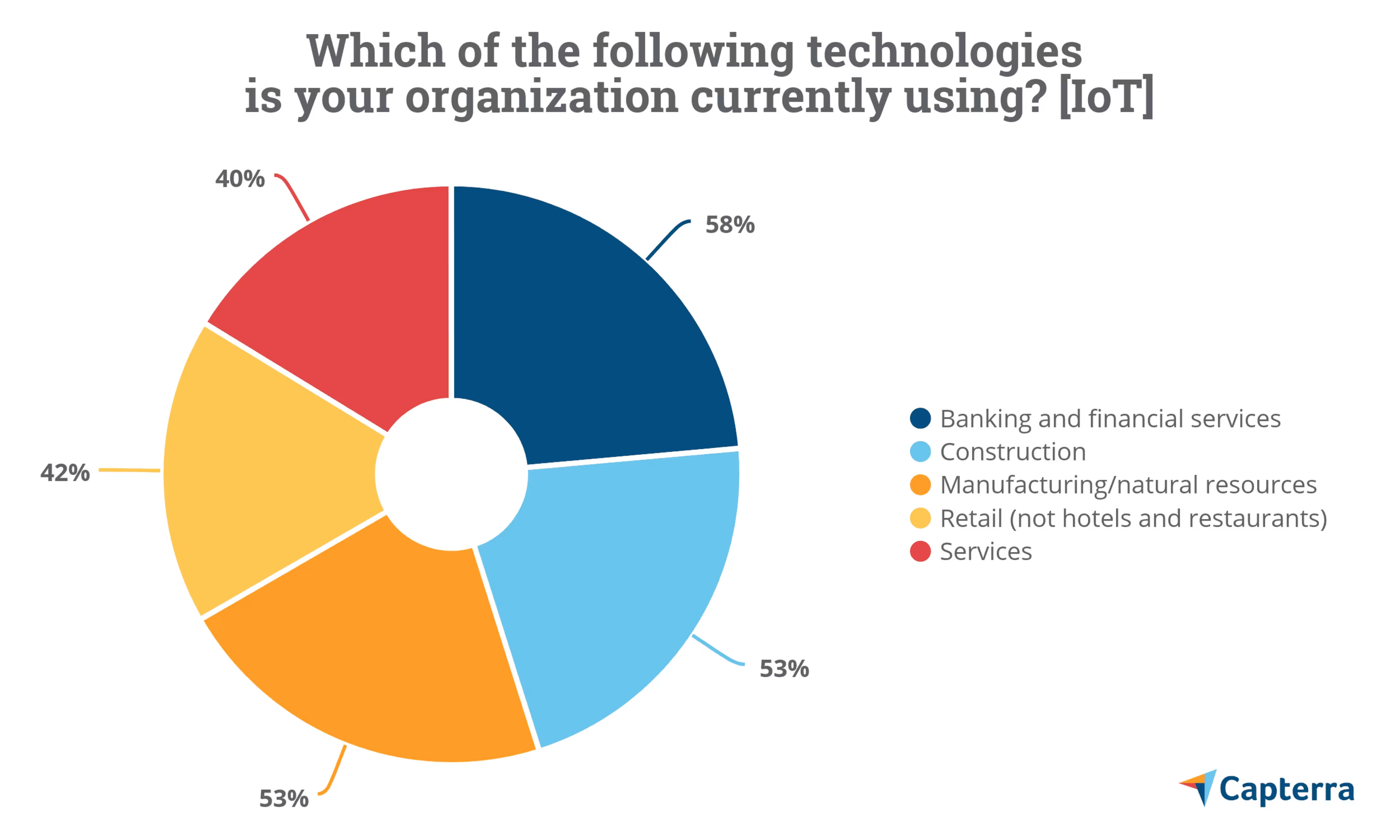
All percentages reflect the number of respondents in each industry currently using the IoT.
Your challenge: Since “smart devices" connect to the internet, they collect large amounts of data. Ninety percent of all data in the world was created within the past two years. This data helps such devices improve their results, and give more targeted recommendations.
But this high volume of data brings problems as well: User privacy (or lack thereof) is a huge challenge for today's SMB owners. Consumers expect to get personal experiences from the brands they interact with. But to do do this, SMB owners must collect and act on large amounts of data that is often personal.
This balance between personal privacy versus experiences is a tough one for businesses of all sizes.
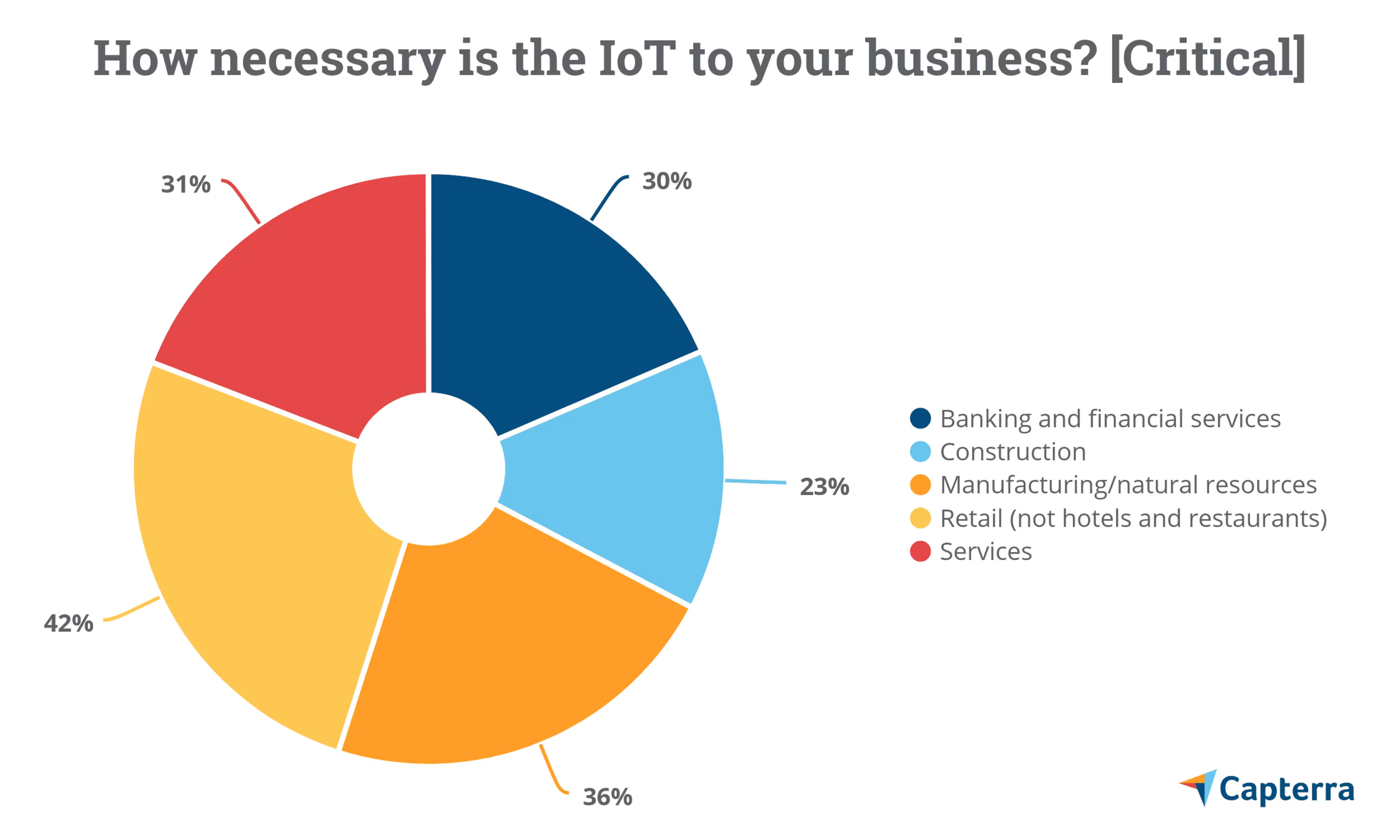
All percentages reflect the number of respondents in each industry who identified the IoT as critical.
Recommended response: Work with your IT team to build an IoT strategy into your cybersecurity plan. You can't separate these two from each other: For all their advantages, IoT technologies produce an enormous amount of personal data that introduces new risks to SMBs.
Forty-seven percent of the SMBs we surveyed have formal IT departments, and more than 1 in 5 (21%) have business staff handle their IT matters. Before making any IoT investments, your SMB's tech and business leaders must establish plans for IoT governance, data ownership and ethics, security, and architecture. Investments in the IoT will fail without a foundation to build on (full research available to Gartner clients).
Don't adopt disruptive technologies alone
SMBs must adopt new technologies within two to three years if they want to gain advantages over competitors. So, even if you're not investing in the IoT right now, you should start researching use cases right now.
If you wait five to seven years to adopt new tech, you might never catch up to your competitors.
In the meantime, don't try to invest in these technologies on your own. One in 3 survey respondents said that they are “solely responsible" for tech purchasing decisions.
This is a risk regardless of which technologies you invest in.
Business leaders underestimate productivity losses associated with introducing new tools and tech to their teams. They also tend to view investments from their own perspectives, and might have blind spots that colleagues can catch.
For example, a CEO might make a business case for using the IoT without knowledge of its technical requirements and whether the company can meet them. Left unchecked and alone, this rogue investment will likely end badly for the business.
To avoid this, build a key committee to attend product demos, give feedback, and make decisions. This is crucial even if you're the one who will make the final buying choice.
You can't anticipate every outcome on your own: Building a strong team from within is the first step toward a future-proof SMB.